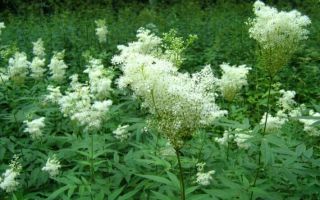Content
- 1 What does meadowsweet look like and where does it grow
- 2 Types of meadowsweet
- 3 The chemical composition of meadowsweet
- 4 What helps and what does meadowsweet treat
- 5 How to take meadowsweet
- 6 The use of meadowsweet in cosmetology
- 7 Contraindications for the use of meadowsweet
- 8 Collecting and harvesting meadowsweet grass
- 9 Conclusion
- 10 Reviews of the beneficial properties and use of meadowsweet
The medicinal properties and uses of meadowsweet are an interesting topic to study, since the plant is often found in folk recipes. The herb can be beneficial for many diseases if you know how to use it correctly and safely.
What does meadowsweet look like and where does it grow
Meadowsweet, or meadowsweet (Filipendula) is a whole genus of herbaceous perennials from the Pink family. There are more than 10 types, differing in size and external features. However, all members of the genus have common features.
The meadowsweet reaches an average of 2 m in height. The root is long and wide, in the photo of the meadowsweet plant it can be seen that the straight stem is densely covered with feathery large leaves. In the middle of summer, the perennial produces small flowers of white or pink color with 6 petals, collected in paniculate-corymbose inflorescences. At the end of the decorative period, many-root fruits appear on the stems.
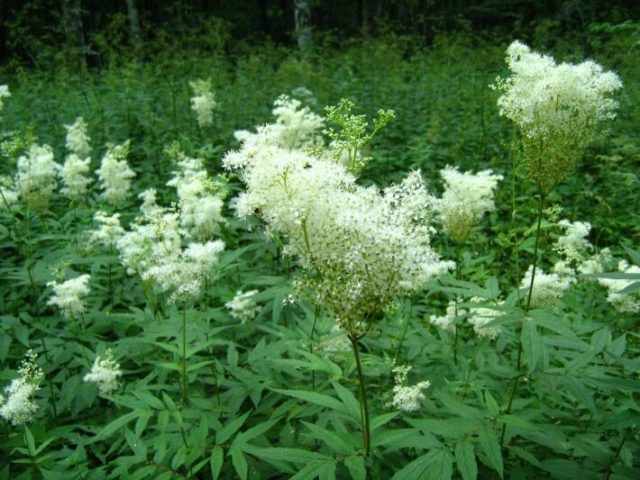
Meadowsweet is widespread throughout the European part of Russia. You can see the plant in shady forests, damp meadows, and river floodplains.
Types of meadowsweet
Perennial meadowsweet can be found in many varieties. The main and most common of them deserve detailed consideration.
Common meadowsweet (Filipendula vulgaris)
Typical species, which is a tall, spreading bush about 80 cm in height. The leaves of the common meadowsweet are feathery. Blooms in late June, brings loose, creamy white paniculate inflorescences.
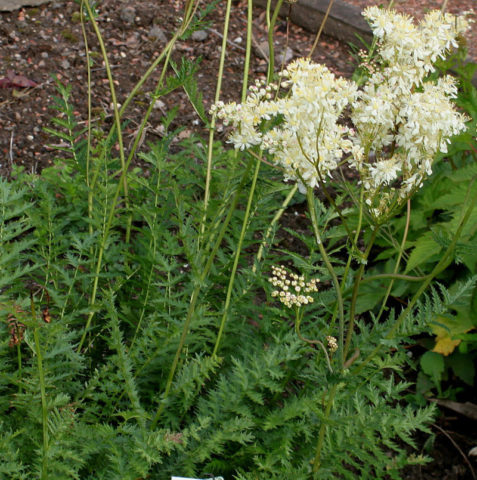
Meadowsweet (Filipendula ulmaria)
The most common species of meadowsweet in Russia, often growing along the banks of reservoirs. It looks like a loose shrub up to 1.5 m tall, with dark green feathery leaf plates. Blossoms in June or early July, the inflorescences of the elm-leaved meadowsweet are large, cream-colored.
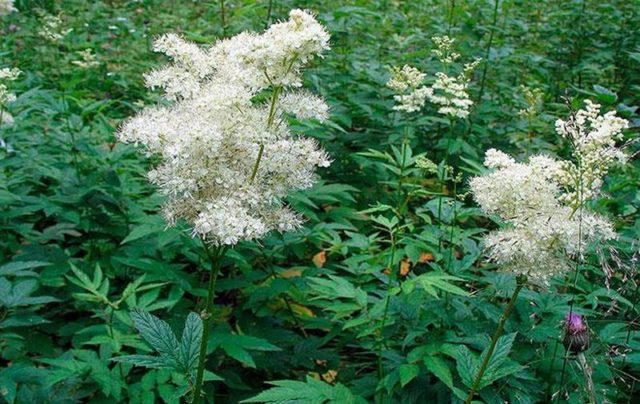
Red meadowsweet (Filipendula rubra)
North American species of meadowsweet with a bush height up to 2.2 m. The silhouette of the plant is spreading, the stems are red-brown and covered with dissected leaves. It enters the decorative period in July or early August, the inflorescences are fluffy, corymbose, consist of white-pink buds.
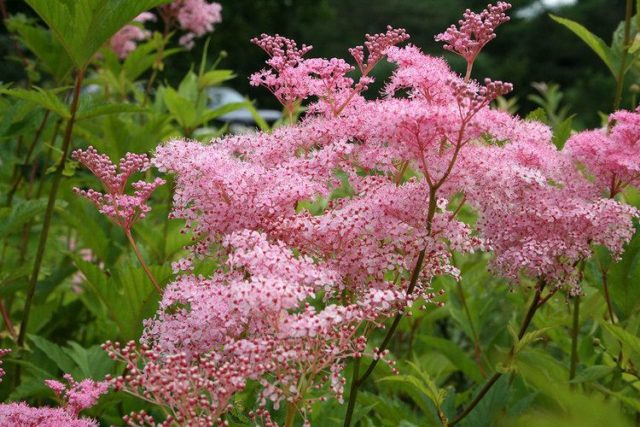
Kamchatka meadowsweet (Filipendula camtschatica)
A tall herbaceous meadowsweet can reach 3 m in height, the stems are densely covered with finger-like bright green leaves up to 30 cm in diameter. White-cream large inflorescences appear in July. The species grows abundantly in Kamchatka, as well as on Sakhalin, the Kuril Islands and Japan.
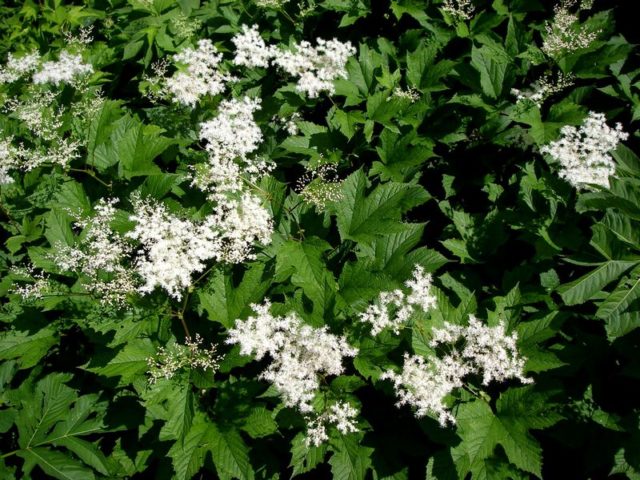
Palm-shaped meadowsweet (Filipendula palmata)
A medium-sized perennial rarely rises above 1 m above the ground, has dissected leaf plates, shaped like a human palm. Blooms from late June to late July, producing fluffy, yellowish-white panicles with a pleasant sweet aroma.
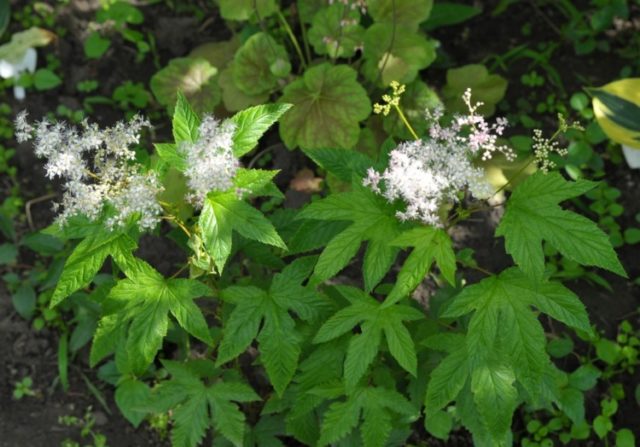
The chemical composition of meadowsweet
The meadowsweet plant is popular in traditional medicine for a reason. The perennial contains many useful substances, namely:
- vitamin C;
- the flavonoids kaempferol and quercetin;
- tannins;
- heparin;
- polyphenols - caffeic and ellagic acids;
- essential oils;
- glycosides isosalicin, monotropitin and spirein;
- vanillin and methyl salicylate;
- fatty acid;
- wax and starch;
- Kakhetians.
The main value in the composition of meadowsweet is salicylic acid and its derivatives. Thanks to these components, the plant acquires pronounced anti-inflammatory and analgesic properties.
What helps and what does meadowsweet treat
In folk medicine, meadowsweet is in great demand. If you brew meadowsweet correctly, it has a very beneficial effect, namely:
- removes excess fluid from the body and relieves swelling;
- increases immune resistance and helps resist viruses and infections;
- has a beneficial effect on the nervous system and improves sleep;
- strengthens blood vessels and normalizes heart function.
Among the indications for the use of meadowsweet, the following diseases can be listed:
- bronchitis and pneumonia;
- sore throat, SARS and flu;
- helminthic invasions;
- epilepsy;
- hypertension;
- diabetes;
- psoriasis, herpes and furunculosis;
- hepatitis and inflammatory diseases of the genitourinary system;
- arthritis, arthrosis and rheumatism;
- neurological pathology;
- bronchial asthma.
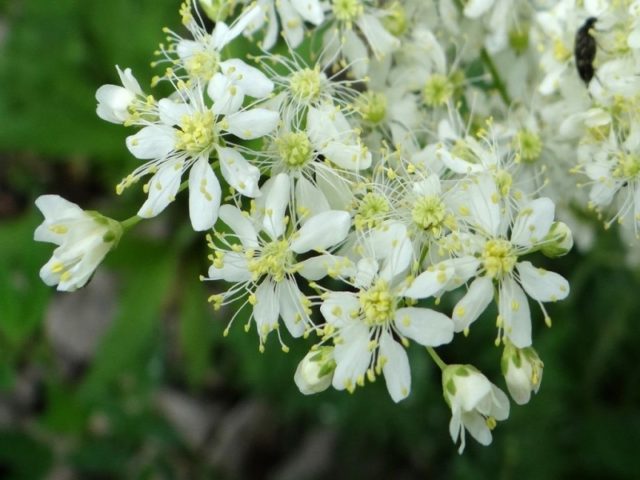
Meadowsweet is useful for digestive disorders. It can be used both with sluggish intestines and with a tendency to spasms, with diarrhea and dysentery.
Medicinal properties of meadowsweet for women
The meadowsweet is used in the fight against gynecological diseases - cystitis, thrush, cervical erosion, endometriosis and even infertility. The benefits of meadowsweet for a woman's body are expressed in the sedative properties of the plant. Decoctions and infusions can be used for insomnia, depression, and increased anxiety.
Medicinal properties of meadowsweet for men
Means based on meadowsweet strengthen blood vessels and equalize blood pressure, so men can take them for the prevention and treatment of hypertension. Meadowsweet helps fight atherosclerosis, reduces the likelihood of heart attacks, and also helps to relieve inflammation in prostatitis and improves kidney function.
The meadowsweet herb is good for men due to its anti-stress properties. Drinking tea with meadowsweet will relieve fatigue and relieve psychological stress.
Useful properties of meadowsweet for children
With proper use, the medicinal properties of meadowsweet help with angina, pneumonia and flu in a child. However, babies up to 12 years old cannot be offered remedies based on a medicinal plant. Meadowsweet can cause allergies or lead to digestive upsets such as nausea, diarrhea and colic.
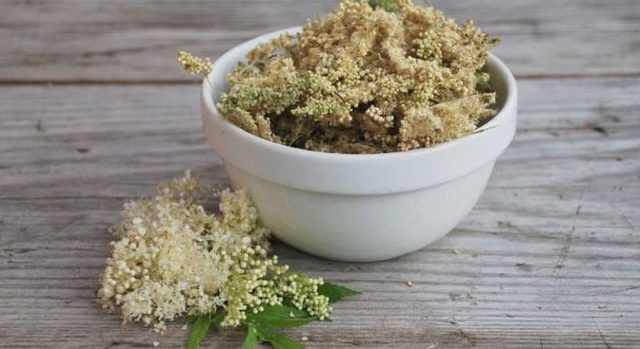
How to take meadowsweet
Traditional medicine offers several basic recipes based on meadowsweet. Each of them can be beneficial, and which remedy to choose depends on the specific disease and characteristics of the organism.
Infusions
Water infusions of meadowsweet have a moderate concentration and rarely cause side effects. Almost everyone can take them in the absence of strict contraindications.
Infusion for edema
With a tendency to severe edema from meadowsweet, you can prepare the following remedy:
- pour 100 g of dried flowers into a thermos;
- pour raw materials with 500 ml of boiling water;
- close the lid and leave for 4 hours.
The finished infusion is filtered through cheesecloth and drunk 100 ml twice a day. The remedy is considered universal, it can also be taken for diarrhea and insomnia.

Infusion for ARVI
For the treatment of colds, it is recommended to use the remedy on fresh meadowsweet flowers. You can brew a meadowsweet using the following algorithm:
- a glass of raw materials is poured with a glass of cold water;
- stir the flowers and close the container with a lid;
- put away in a dark cool place for 12 hours;
- after the expiration of the period, filter the agent and add 100 ml of calendula tincture to it.
For the treatment and prevention of colds, you need to drink a meadowsweet three times a day, a small spoonful, preferably on an empty stomach.
Tinctures
Alcoholic tinctures of meadowsweet have a strong anti-inflammatory effect. However, not everyone can use them, for example, with an allergy to alcohol or with chronic liver ailments, strong remedies are prohibited.
Tincture for chronic gastritis
For gastritis with slow gastric acid production, you can make the following homemade remedy from meadowsweet:
- pour 500 ml of vodka 25 g of fresh meadowsweet flowers;
- add 20 g of sugar;
- stir and remove for 2 weeks under a lid in a dark place.
The finished tincture will need to be filtered. Take it three times a day, 1 small spoon.
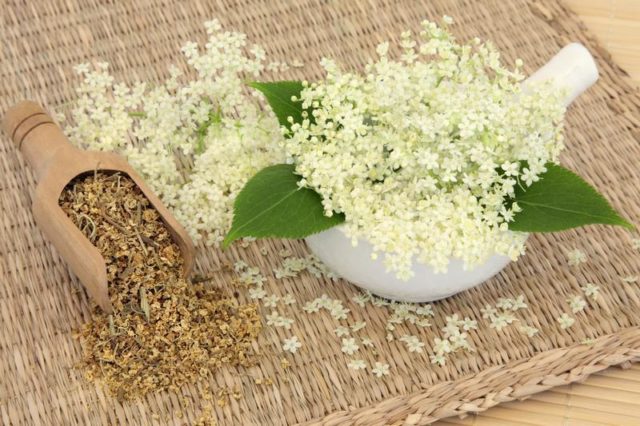
Tincture for treating wounds and cuts
Another version of the strong tincture is intended for external use. The tool is prepared as follows:
- 500 ml of quality vodka is diluted with an equal amount of water;
- the crushed leaves of meadowsweet are poured with the resulting solution in a ratio of 5 to 1;
- put away in a dark and cool place for 10 days.
The finished product can be used to treat cuts, scrapes, healing burns and boils. Meadowsweet tincture is also used as a face lotion for acne-prone skin.
Decoctions
Concentrated decoctions are usually prepared from the leaves and medicinal roots of meadowsweet. They are used for digestive disorders and even for cancer.
Broth for oncology and leukemia
In the complex treatment of oncological diseases, you can use a decoction of meadowsweet, it will strengthen the body and improve the composition of the blood. The recipe looks like this:
- dry meadowsweet roots are crushed in the amount of 2 small spoons;
- pour a glass of boiling water in an enamel saucepan;
- boil for about half an hour in a water bath, and then insist until it cools.
The filtered agent is taken 3 large spoons on an empty stomach three times a day. The course duration is 3 weeks.
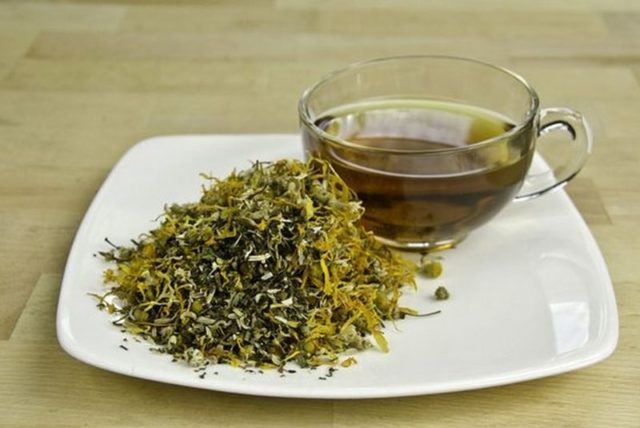
Decoction for diarrhea
For diarrhea, traditional medicine recommends preparing the following decoction:
- a large spoonful of crushed leaves and seeds of meadowsweet is poured with 200 ml of liquid;
- keep in a water bath for about 15 minutes;
- insist under the lid for an hour.
You need to drink the broth in 2 large spoons after each episode of diarrhea. Treatment with meadowsweet continues until the symptoms disappear.
Ointment
Dry or fresh meadowsweet flowers can be used to make a homemade ointment with strong anti-inflammatory properties. They do it like this:
- 10 g of raw materials are thoroughly crushed;
- mixed with 40 g of petroleum jelly;
- bring the product to homogeneity.
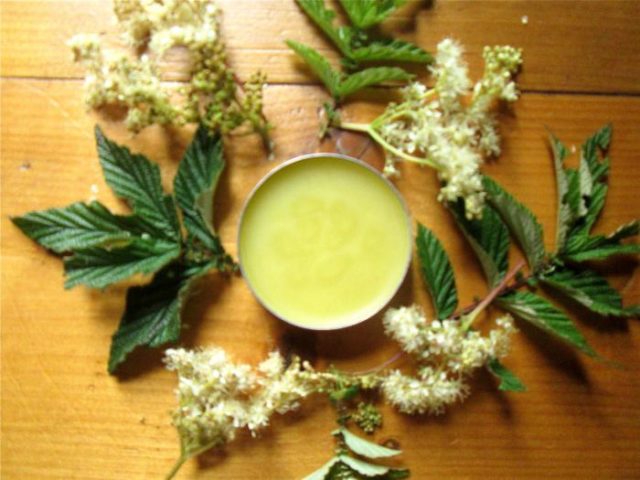
Meadowsweet ointment can be used to treat skin with psoriasis and dermatitis. Also, the remedy has a good effect on bruises and joint diseases.
Tea
In the prevention of colds, the health benefits and harms of meadowsweet tea are used. Making a drink is very simple:
- 2 large spoons of finely chopped leaves are brewed in 1 liter of boiling water for 15 minutes;
- add a spoonful of natural honey;
- drink tea during the day at intervals of 2-3 hours.
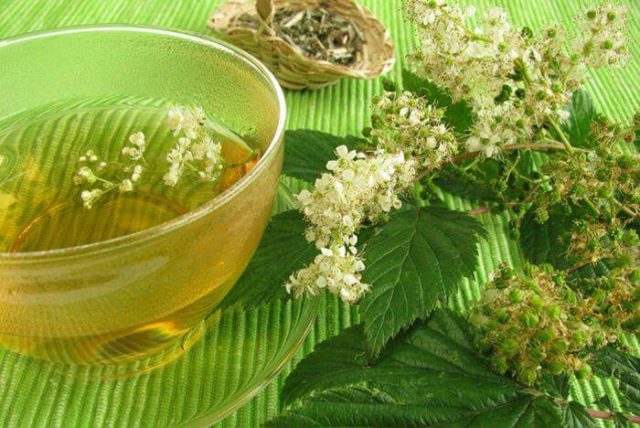
If you wish, you can simply put a pinch of dried flowers or meadowsweet leaves in ordinary teas - green, black and herbal. For example, ivan tea with meadowsweet has good immunomodulatory properties.
Oil
For external use for radiculitis, rheumatism and muscle pain, traditional medicine suggests using meadowsweet oil. You can cook it at home, but it is done like this:
- 50 g of finely chopped meadowsweet leaves are placed in a glass jar;
- pour in olive oil so as to completely cover all the grass;
- mixed and removed for 2 weeks in a dark place.
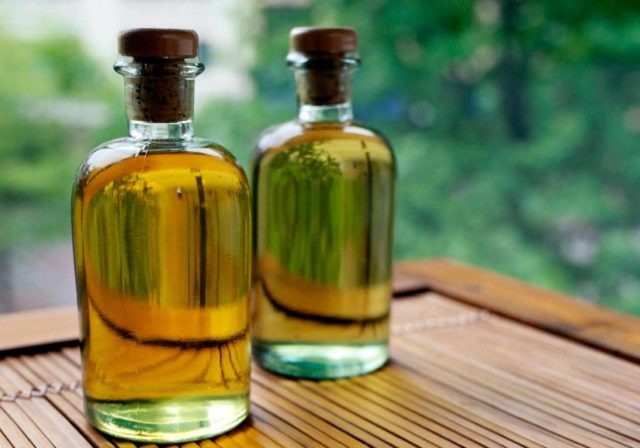
Then the tool will need to be filtered through cheesecloth from the sediment. Before use, the oil extract of meadowsweet can be slightly warmed in a water bath. It is used for rubbing joints and muscles, as well as for massage.
The use of meadowsweet in cosmetology
The healing properties of meadowsweet are used not only in medicine. Means from meadowsweet are highly valued in home cosmetology. The plant helps get rid of acne and blackheads, tightens pores and regulates sebum production, nourishes and moisturizes the skin. Decoctions and infusions based on it allow you to strengthen the hair and give it additional volume.
Acne face mask
For oily skin and acne-prone skin, you can use the following mask:
- a glass of meadowsweet broth is mixed with 1 small spoonful of carrot juice;
- add 1 small spoonful of honey;
- stir the product thoroughly.
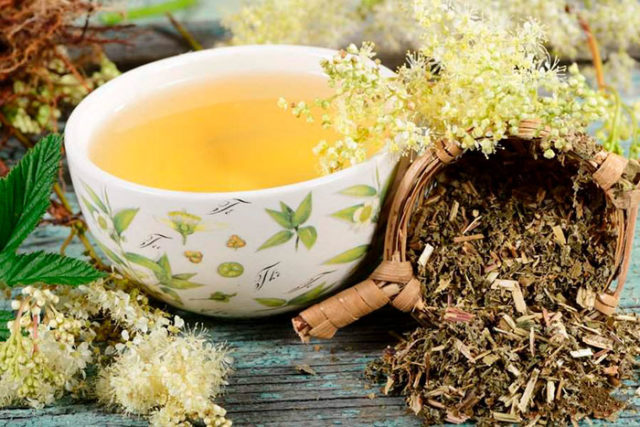
You need to distribute the mask over the face in 5 layers, each of which must dry before applying the next. The mixture is left on the skin for 20 minutes and then washed off. If you repeat the procedure regularly, then soon the epidermis will become noticeably cleaner and velvety.
Decoction for hair growth
For dry hair that is prone to falling out, it is useful to use a decoction of meadowsweet. To prepare it you need:
- pour 400 ml of hot water into a large spoonful of flowers;
- boil the raw materials for half an hour;
- insist under the lid for the same time.
The hair is rinsed with a strained broth after each wash for a month. The product stimulates dormant follicles to grow and helps to give the hair a splendor.
Contraindications for the use of meadowsweet
In some cases, meadowsweet can be harmful to health. It is not recommended to take it when:
- individual plant allergy;
- with a tendency to constipation;
- with hypotension;
- with poor blood clotting;
- during pregnancy and lactation.
Collecting and harvesting meadowsweet grass
The flowers and leaves of the plant are harvested during flowering - from early July to August, depending on the variety. After collecting, the raw material is dried in the shade with good ventilation, spread out on a flat surface.
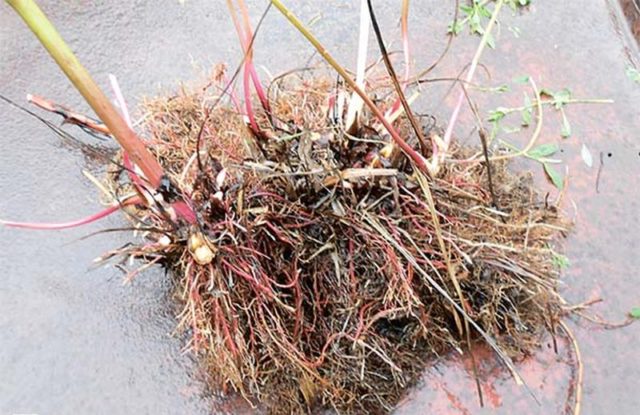
Collect meadowsweet roots in early spring or autumn. They are dried in the same way as the ground parts - in a warm and dry place away from direct sun. You need to store rhizomes, leaves and flowers in a glass or plastic container in a darkened cabinet with low humidity, and the shelf life is 3 years.
Conclusion
The medicinal properties and use of meadowsweet are beneficial for colds, digestive disorders and joint ailments. It is possible to prepare infusions, decoctions and ointments from the plant, and there are quite few contraindications for medicines.
Reviews of the beneficial properties and use of meadowsweet

